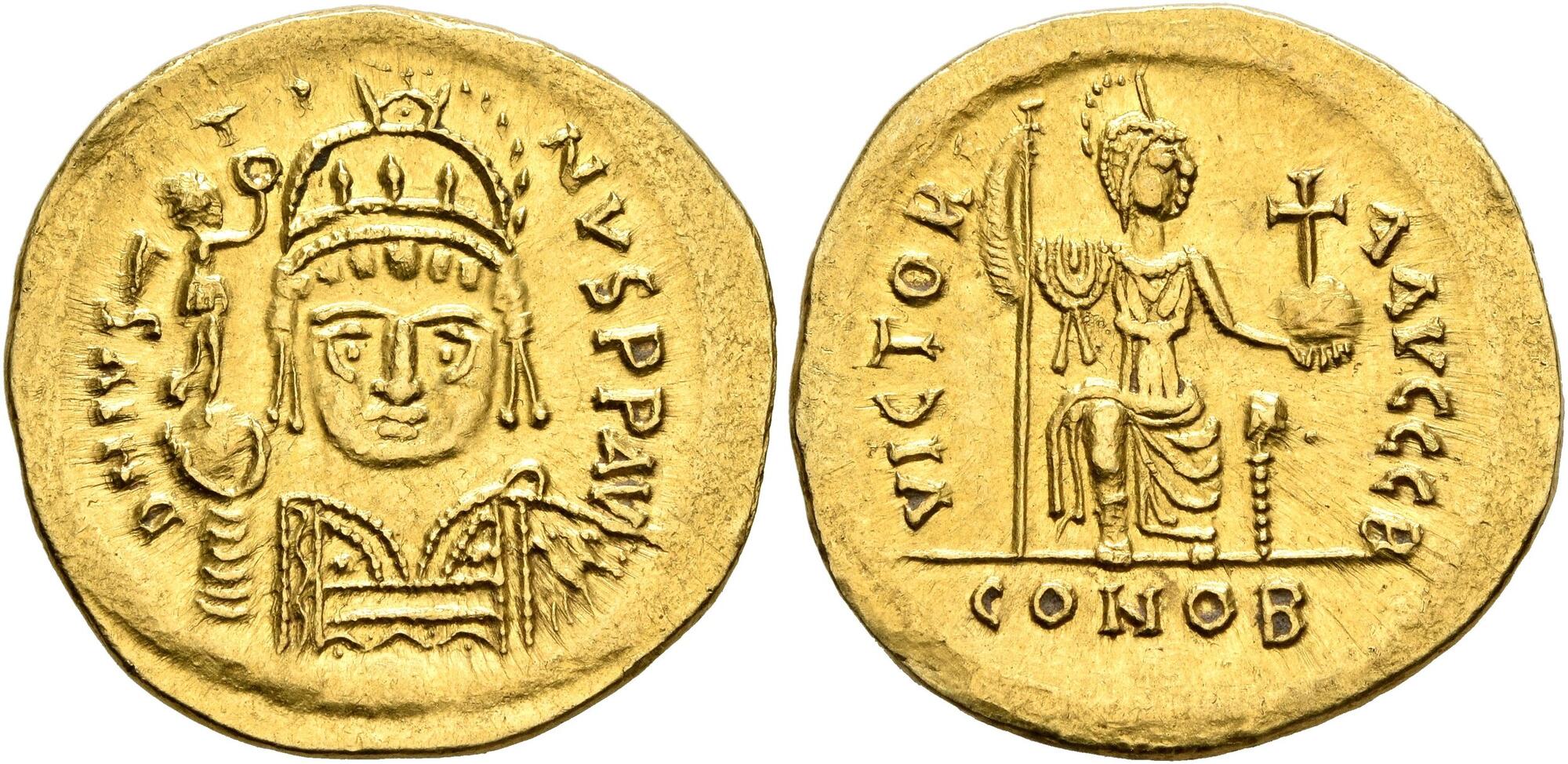S 114 - Carthage (Justin II), gold, solidi (565-578 CE)
From SILVER
565 CE - 578 CE Gold 90,270 kg
Description
| ObverseInscription or printing placed on the obverse.: | D N IVSTINVS P P AV (Latin).Helmeted, diademed and cuirassed bust of Justin II facing, holding Victory on globe in his right hand and with a shield, decorated with a horseman, over his left shoulder |
| ReverseInscription or printing placed on the reverse.: | VICTORI AAVCCC CONOB (Latin).Constantinopolis seated facing on throne, head to right, holding long scepter in her right hand and globus cruciger in her left |
Mint and issuing power
| MintIdentifies the place of manufacture or issue of a numismatic object.: | Carthage | Ancient regionAncient region.: | Zeugitana | Modern countryModern country: Tunisia | AuthorityIdentifies the issuing power. The authority can be "pretended" when the name or the portrait of X is on the coin but he/she was not the issuing power. It can also be "uncertain" when there is no mention of X on the coin but he/she was the issuing power according to the historical sources: | Justin II (Byzantine emperor, 565-578 AD) |
Chronology
| FromIdentifies the initial date in a range assigned in a numismatic context. | 565 CE | toIdentifies the final date in a range assigned in a numismatic context.. | 578 CE | PeriodTime period of the numismatic object.: Byzantine Empire |
Physical description
| MetalThe physical material (usually metal) from which an object is made.: | Gold |
Median weightMedian of the weights of numismatic objects (in grams). in grams | 4.40 | DenominationTerm indicating the value of a numismatic object. Examples: tetradrachm, chalkous, denarius.: | soidus | StandardStandard.: |
Image

S114 Carthage Justin.jpg [1]
References
| Die study referencePublication of the study: | Morrisson 19881Morrisson 1988 | ||
| Coin series referenceReference to coin series study: | |||
Obverse dies distribution
no distribution is available
Reverse dies distribution
no distribution is available
Quantification
| Number of obversesNumber of obverse dies. ᵖ (o) | 35 | Number of singletons (o1)The number of singleton coins. ᵖ | |
| Number of reverse diesNumber of reverse dies. (r) | 45 | Number of coinsNumber of coins. (n) | 48 |
| Coins per obverse dieNumber of coins per obverse die. (n/o) | 1.37 | Coins per reverse dieNumber of coins per reverse die. (n/r) | 1.07 |
| Reverse per obverse ratioRatio of obverse dies divided by reverse dies. (r/o) | 1.29 | Percentage of singletons (o1)number of coins (n) divided by the number of singletons (o1) ᵖ | % |
| Original number of dies (O) (Carter 1983 formula)The estimation of the number of coins according to Carter 1983 ᵖ | 102.58 | Coins struck if 20,000 as average productivity per dieCoins made if the average productivity for obverses (according to Carter) is 20,000. ᵖ | 2,051,600 |
| Original number of dies (O) (Esty 2011 formula)The estimation of the number of coins according to the singleton formula in Esty 2011 ᵖ (O) | 129.23 | Survival rate if 20,000 as average productivity per dieSurvival rate if average productivity is 20,000. ᵖ | 0.00002 |
| Coverage (o = % of O) (Esty 1984 formula)Esty 1984 - coverage (% of O) ᵖ (o = % of O) | % | Die productivity if survival rate 1/2,000Average productivity if survival rate is 1/2,000. ᵖ | 935.85 |
| Weight of silver (in kg) if 20,000 coins per die (O = Carter formula)Carter 1983 * Median weight * 20000 (*10 if gold or electrum) ᵖ | 90,270 kg <br /> 90,270 kg | Die productivity if survival rate 1/5,000Average productivity if survival rate is 1/5,000. ᵖ | 2,339.64 |
Remarks
References
- ^ Morrisson, Cécile (1988) "Carthage: the Moneta Auri under Justinian I and Justin II, 537-578", in W. Hahn et W. E. Metcalf (éd.), Studies in early Byzantine Gold Coinage, Numismatic Studies 17, New York, p. 41-64.